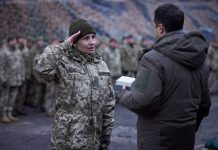
In spite of their shipment from London to Kyiv, the British Challenger 2 tanks have not yet been engaged in the Ukrainian conflict. This information was disclosed in an article authored by British Lieutenant Colonel Steward Crawford and published in the Daily Express.
Lt. Col. Crawford’s article indicated that as of its publication, there was no concrete proof indicating the presence of Challenger 2 tanks within Ukrainian territory. This viewpoint was echoed by distinguished war correspondent Jonathan Beale, who is currently stationed in Ukraine. Beale shared on social media that he had consulted two high-ranking Ukrainian military generals regarding the tanks’ location. Their collective response suggested that the Ukrainian armed forces did not possess these tanks.
Lt. Col. Crawford proposed the notion that the Ukrainian military might not have yet employed the Challenger 2 tanks in active combat situations, speculating that they might be stationed elsewhere. Crawford’s analysis also raised concerns about potential challenges that could arise if these tanks were to be deployed on the front lines. He emphasized the vulnerability of these vehicles to drone attacks and mines, noting that this susceptibility extends beyond the Challenger 2 to include the German Leopard 2 tanks as well.
Earlier, in early July, reports had emerged about the Ukrainian military facing difficulties in integrating the Challenger 2 tanks into their operational strategies. These challenges were attributed to specific conditions stipulated by the British government.
Russian Claims Regarding Challenger Tanks
Our previous report from June had disclosed Russian claims of sighting a British Challenger 2 tank for the first time, positioned near the frontlines of the ongoing conflict in Ukraine. These allegations have gained momentum due to a widely circulated video on the Telegram social network, which was presented as evidence by the author.
The video under discussion depicts a British Challenger 2 tank navigating a dusty rural road. The scene showcases residences with distinctive high-pitched roofs, a characteristic feature of both Ukrainian and Russian village architecture.
Notably, the road’s proximity and the defensive structures surrounding the houses, including towering sand embankments and strands of barbed wire, have led RVvoenkory to speculate that the footage was captured in a location much closer to the heart of the conflict, rather than far from the frontline.
Request for Non-Participation Assurances
London has asked Kyiv for explicit assurances that these tanks will refrain from engaging in risky operations to avoid potential capture or destruction by the Russian military. Earlier this year, in January, an article in the British tabloid The Sun garnered mixed reactions. The article highlighted the delivery of 14 Challenger 2 tanks to the Ukrainian armed forces.
The author, Mr. Jerome Starkey, reported that the British Ministry of Defense is contemplating evacuation plans for the Challenger 2 tanks. He cited an anonymous MoD source cautioning against the potential disaster if a Challenger 2 tank were to fall into the hands of Russian invaders.
Furthermore, Mr. Starkey disclosed that, according to his source, the British and Ukrainian military commands are collaboratively formulating such a plan. London is seeking assurance from Kyiv that they will secure a British tank in a safe location if any of the 14 tanks become compromised.
Concerns about Tank Armor
The crux of this concern revolves around the tank’s armor. Similar to the American Abrams and British Challenger 2, the armor is among the most classified aspects. The Challenger 2 boasts an intricate composite armor consisting of uranium-absorbing compounds, ceramics, and steel.
BulgarianMilitary.com reminds its readers that Washington holds comparable concerns. Consequently, the U.S. is deliberating on which export version to provide to Ukraine, likely a considerably downgraded iteration of the original tank in the U.S. Army’s inventory.
However, London lacks this luxury and is directing its efforts towards battlefield strategies. As per Mr. Starkey’s account, the British MoD aims to persuade the Ukrainians to avoid deploying the Challenger 2 in areas where a Russian offensive is improbable. The concern stems from the potential for Russians to capture or obliterate a Challenger 2 tank and subsequently analyze its armor.
In the event of this situation, the author recommends that the Ukrainians swiftly remove the tank from combat. According to the British source, in case of tank damage, the primary recourse is on-site repair or towing using specialized armored repair equipment.
This is the preferred course of action for both Ukrainians and Britons. Yet, an unanswered question hangs: what occurs to the damaged tank if Ukrainian forces retreat and leave it on the battlefield? “The worst-case scenario is the tank getting destroyed as the lines collapse and friendly forces retreat,” the source revealed to The Sun.
Training for ‘Tank Removal’
The British MoD’s “emergency plan” for rescuing the Challenger 2 also entails training Ukrainian soldiers on how to extract the tank from the battlefield in the event of a fire. Essentially, Kyiv has two options: to either keep these tanks well behind the frontlines or have an evacuation apparatus ready behind each tank to swiftly pull it back.
London and Kyiv are also contemplating a third option – enlisting a private military company to salvage the tank if it gets damaged and the Ukrainians are unable to salvage it.
The Challenger 2 has experienced only one defeat in its military history – a lone tank destroyed. This incident occurred during the Iraq War and resulted from friendly fire. Intriguingly, the British tank holds the record for hitting an enemy tank from a distance of 2.5 miles, an achievement also accomplished during the Iraq conflict.





